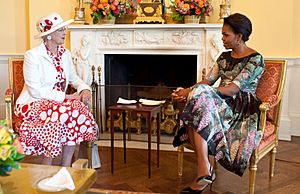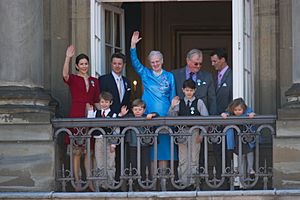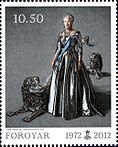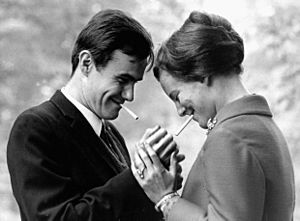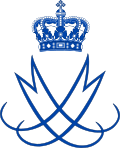Margrethe II facts for kids
Quick facts for kids Margrethe II |
|||||
|---|---|---|---|---|---|
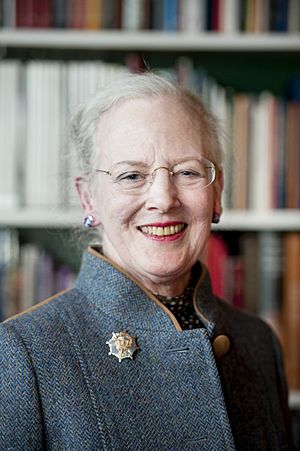
Portrait, 2012
|
|||||
| Queen of Denmark | |||||
| Reign | 14 January 1972 – 14 January 2024 | ||||
| Predecessor | Frederik IX | ||||
| Successor | Frederik X | ||||
| Born | 16 April 1940 Amalienborg, Copenhagen, Denmark |
||||
| Spouse |
Henri de Laborde de Monpezat
(m. 1967; died 2018) |
||||
| Issue |
|
||||
|
|||||
| House | Glücksburg | ||||
| Father | Frederik IX | ||||
| Mother | Ingrid of Sweden | ||||
| Religion | Protestant | ||||
| Signature | |||||
Margrethe II was the Queen of Denmark for 52 years. She was born on April 16, 1940, and ruled from January 14, 1972, until she stepped down on January 14, 2024. She was the second-longest-reigning Danish monarch ever.
Margrethe was born into the House of Glücksburg, a royal family branch. Her grandfather, King Christian X, was ruling at the time. She is the oldest child of King Frederik IX and Queen Ingrid. In 1953, a new law allowed women to inherit the throne, making her the next in line.
In 1967, she married Henri de Laborde de Monpezat. They had two sons, Frederik and Joachim. Margrethe became Queen when her father passed away in January 1972.
Besides her royal duties, Margrethe is also a talented artist. She has worked as a designer for theater sets and costumes. She has also illustrated books, including some by J. R. R. Tolkien. People in Denmark really liked her, and support for the monarchy grew during her reign. Her oldest son, Frederik X, became the new King after she stepped down.
Contents
Early Life and Schooling
Margrethe was born on April 16, 1940, in Copenhagen, Denmark. She was born at Frederik VIII's Palace, which is part of the Danish royal family's main home. She was the first child of Crown Prince Frederik (who later became King Frederik IX) and Crown Princess Ingrid (who later became Queen Ingrid).
Her birth happened just one week after Nazi Germany started its occupation of Denmark during World War II. She was named Margrethe after her grandmother. She also received the Icelandic name Þórhildur because her grandfather was also the King of Iceland. Her family and close friends affectionately call her "Daisy."
Margrethe's younger sisters, Benedikte and Anne-Marie, were born in 1944 and 1946. The princesses grew up in royal palaces in Copenhagen and North Zealand. They spent summer holidays at Gråsten Palace. In 1947, her father became King Frederik IX after King Christian X died.
Her Education
Margrethe went to a private school in Copenhagen and finished in 1959. She also studied at a boarding school in England for a year. Later, she studied archaeology at Girton College, Cambridge. She also studied political science at Aarhus University and attended the Sorbonne and the London School of Economics. She is a member of the Society of Antiquaries of London, which is a group for people who study old things.
Next in Line to the Throne
When Margrethe was born, only males could become King of Denmark. This was due to old laws from the 1850s. Since Margrethe had no brothers, people thought her uncle, Prince Knud, would become king.
However, things began to change in 1947. Her father became king, and it became clear that Queen Ingrid would not have more children. Because Frederik and his daughters were very popular, and women were taking on more important roles in Danish life, people wanted to change the law. In 1953, a new law was passed. This law allowed women to inherit the throne if they did not have a brother. This meant Princess Margrethe became the next in line. In 2009, the law changed again, making it so the oldest child, regardless of gender, would inherit the throne.
When she turned 18 in 1958, Margrethe got a seat in the Danish Council of State. She could lead meetings when the King was away. In 1960, she visited the United States with her cousins. They even met famous people like Dean Martin, Jerry Lewis, and Elvis Presley at a movie studio. She also visited the Faroe Islands and Greenland in 1959 and 1960.
Marriage and Family Life
While studying in London, Margrethe met Henri de Laborde de Monpezat, a French diplomat. They announced their engagement in 1966 and married on June 10, 1967. Their wedding reception was held at Fredensborg Palace. Henri became "His Royal Highness Prince Henrik of Denmark." They were married for over 50 years until he passed away in 2018.
Less than a year after their wedding, Margrethe had her first son, Frederik, in 1968. Danish kings traditionally alternate between the names Frederik and Christian. She chose Frederik for her oldest son. Their second son, Joachim, was born in 1969.
In 1974, Margrethe and Henrik bought a castle in Southern France. In 2008, she announced that her sons' children would also be called "Count or Countess of Monpezat." In 2022, the Queen decided that Prince Joachim's children would only use their Count and Countess titles. This was to help them live more normal lives without the strict duties of being a Prince or Princess of Denmark.
Margrethe and her husband loved dachshunds and have had them since the 1970s. She still has one dachshund named Tilia.
Her Time as Queen
Becoming Queen

On January 3, 1972, King Frederik IX had a heart attack. Margrethe became regent, meaning she took over his duties. The King died on January 14, and Margrethe became Queen at age 31. She was the first female Danish ruler under the new law. The Prime Minister announced her as Queen from the balcony of Christiansborg Palace the next day.
She chose her royal number, Margrethe II, to honor a 14th-century Danish queen. Her motto was "God's help, the love of the people, Denmark's strength." She kept only the title "Queen of Denmark."
Her Role in Government

The Queen's main jobs were to represent Denmark to other countries and to be a symbol of unity at home. She did this by opening events, attending celebrations, and opening new bridges. She also welcomed foreign ambassadors and gave out awards.
As a constitutional monarch, Margrethe did not get involved in politics. She did not share her political opinions. Even though she could vote, she chose not to, to show she was fair to everyone.
The Queen met with the prime minister and the foreign affairs minister every Wednesday. After an election, she would meet with the leaders of all the Danish political parties. The leader who could get enough support to form a government would then be asked by the Queen to become the new prime minister.
Once a government was formed, the Queen officially appointed it. She was the head of state and signed new laws. However, in practice, the government ministers made most of the decisions.
It was a tradition for Margrethe to host annual New Year events. These included banquets and receptions for government officials, military officers, and diplomats.
Official Duties
During her reign, Margrethe supported many Danish and foreign organizations. These included museums, welfare societies, and sports groups. She knew a lot about all parts of Denmark. In 2016, she helped write a book about Denmark's history.
She was also the colonel-in-chief of a British Army regiment. This was a tradition that started in 1906. As Queen, Margrethe hosted 42 official visits from other countries. She also made 55 state visits to other countries herself.
Royal Homes
Her official homes were Amalienborg in Copenhagen and Fredensborg Palace near Hillerød. Her summer homes were Marselisborg Palace near Aarhus and Gråsten Palace near Sønderborg. Gråsten Palace was once her mother's home.
Views on Immigration
In 1984, Queen Margrethe spoke about xenophobia (dislike of people from other countries) in Denmark. She said that Denmark was a safe place for many refugees. She asked Danes to be more welcoming and not to be rude or unkind to newcomers.
In a 2016 book, Margrethe shared her updated thoughts. She said that Danes should be clearer about their culture and values to help new arrivals understand them. She also felt that Danes had underestimated how hard it is to help immigrants fit in.
Special Anniversaries
Margrethe celebrated her Silver Jubilee (25 years on the throne) in 1997. She had a church service and a special dinner with other royal family members from Scandinavia. On January 14, 2012, she celebrated her Ruby Jubilee (40 years). This was marked with a church service, a concert, a carriage parade, and a gala dinner.
Her Golden Jubilee (50 years) was on January 14, 2022. Celebrations were planned for later that year. However, after the death of Queen Elizabeth II of the United Kingdom, some of the celebrations were changed. Between Elizabeth II's death and her own abdication, Margrethe was Europe's longest-reigning monarch. She was also the only reigning queen in the world.
Longest Reigning Monarch
In July 2023, the Danish Royal House announced that Margrethe II was Denmark's longest-reigning monarch who was actively ruling. While Christian IV reigned for more than 59 years, he was not officially crowned until later in his reign.
Stepping Down from the Throne
On December 31, 2023, Margrethe announced that she would step down as Queen. This happened on January 14, 2024, exactly 52 years after she became Queen. She explained that her age and health issues, especially a major back surgery, made her think about passing on the responsibility.
Her older son, Frederik, became Frederik X. Margrethe said she hoped the new King and Queen would receive the same trust and support she had. Since stepping down, she is called "Her Majesty Queen Margrethe." She can still act as regent if the King or Crown Prince Christian are unable to perform their duties.
Health and Well-being
Queen Margrethe II has had some health challenges. She had several knee operations due to injuries and osteoarthritis. In 1994, she was treated for cervical cancer. In 2003, she had a long operation for back pain.
She had COVID-19 twice in 2022, but both times she had mild cases and recovered quickly. In February 2023, she had a "major back surgery" for ongoing back pain. The surgery went well, and she returned to her duties on her birthday in April.
Margrethe was known for being a chain smoker. In 2006, the Royal Court announced that she would only smoke in private. In September 2024, she was hospitalized after a fall.
Hobbies and Interests
Archaeology
Margrethe loves archaeology, which is the study of old human history through digging up artifacts. She has taken part in several excavations in places like Italy, Egypt, and Denmark. She shared this interest with her grandfather, Gustaf VI Adolf of Sweden.
Church Textiles
Since the 1970s, Margrethe has designed and embroidered many special fabrics for churches. These include robes for priests and altar cloths for churches in Denmark, Greenland, Germany, and England. She also designed an altarpiece for a church in Norway.
Découpage Art
Since the mid-1970s, Margrethe has enjoyed découpage. This is an art technique where you cut out pictures from magazines or books and combine them to make new designs. She often uses this technique for decorations in royal palaces. Her découpage works often show themes from literature, myths, or art history. .....
Embroidery
As a child, Margrethe preferred drawing, but she started embroidering in 1960. She has made many embroideries as gifts or for her own rooms. She designs her own patterns, which often include swirling shapes and monograms. She has designed patterns for the Danish Handcraft Guild, including cushion covers and dinner mats. She also makes evening bags and spectacle cases for friends and family.
Films
The Queen has worked as a screenwriter for two films based on Hans Christian Andersen's fairy tales: The Snow Queen (2000) and The Wild Swans (2009). She also narrated The Snow Queen. .....
Monograms
Margrethe has designed several monograms, which are special symbols made from letters. In 2004, she designed the official monogram for Princess Ingrid Alexandra of Norway. She also designed her own personal monogram. She designed monograms for her son Frederik X, daughter-in-law Mary, and grandson Christian. She also designed joint monograms for other royal couples.
Scenography and Costume Design
Margrethe is very involved in ballet as a designer of sets and costumes. She designed costumes for the Royal Danish Ballet's A Folk Tale and for the 2009 film The Wild Swans. She also designs her own colorful and unique clothes. .....
She has designed sets and costumes for many ballets, especially for the Tivoli Ballet Theatre since 2001. These include ballets like Thumbelina, The Tinderbox, and The Nutcracker.
Visual Art
Margrethe is a talented painter and has shown her artwork in many exhibitions. In 2000, she illustrated her husband Prince Henrik's poetry book Cantabile. In 2015, she and Queen Sonja of Norway had an exhibition of their nature-inspired paintings.
She also illustrated Danish versions of The Lord of the Rings books under the name Ingahild Grathmer. She sent her drawings to the author, J. R. R. Tolkien, who was amazed by how similar her style was to his own.
Awards and Honors
From Denmark
- Knight of the Order of the Elephant (Denmark's highest order)
- Grand Commander of the Order of the Dannebrog
- Various medals for service and anniversaries.
- Nersornaat Medal for Meritorious Service, 1st Class (from Greenland)
From Other Countries
Margrethe has received many high honors from countries all over the world. These include:
- Grand Cross of the Legion of Honour (France)
- Grand Cross Special Class of the Order of Merit of the Federal Republic of Germany
- Collar of the Order of the Chrysanthemum (Japan)
- Knight Grand Cross of the Order of the Netherlands Lion
- Grand Cross with Collar of the Order of St. Olav (Norway)
- Lady of the Order of the Golden Fleece (Spain)
- Member of the Royal Order of the Seraphim (Sweden)
- Stranger Lady Companion of the Order of the Garter (United Kingdom)
Other Awards
- 2004: The Hans Christian Andersen Award Committee's Honorary Award
- 2022: Foreningen Norden's Nordic Language Prize
- 2024: Robert Award for Best Costume Design
- 2024: Association for Book Crafts' Honorary Award
Things Named After Her
- Awards: Queen Margrethe II's Science Award (2015)
- Places: Queen Margrethe II Land in Northeast Greenland (named in 1990 for her 50th birthday)
- Objects: The Margrethe Bowl (a mixing bowl designed by her uncle in 1947)
- Buildings: Margrethe's Church in Valby (1968)
Honorary Military Roles
- 1972–2024: Colonel-in-Chief of the Princess of Wales's Royal Regiment (United Kingdom)
See also
 In Spanish: Margarita II de Dinamarca para niños
In Spanish: Margarita II de Dinamarca para niños





